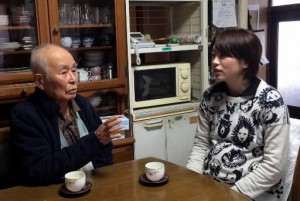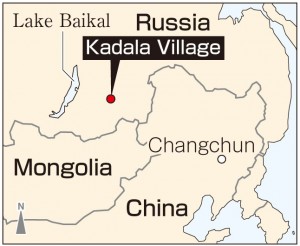Aging survivor of detention in Siberia recounts hardships at internment camp after the war
Mar. 1, 2016
by Kyoko Morioka, Staff Writer
Last year, which marked the 70th anniversary of the end of World War II, Masao Togashi, 96, a resident of Asakita Ward, Hiroshima, who was detained in Siberia after the war ended, began recounting his experiences of that time in response to the urging of family members. His capture by the former Soviet Army; life in the internment camp and forced labor in the bitter cold; and fellow captives who died thinking of their homeland...these were the memories of the four years and two months Mr. Togashi spent in Siberia that he mustered up the courage to recall.
“I don’t actually want to talk about such misery and I would rather have a world without war,” Mr. Togashi said to his eldest son, Masashi, 58, who lives with him, and his granddaughter, Shoko Tsuda, 28, a resident of Uji, Kyoto. When the war ended, Mr. Togashi was in Hsinking (present-day Changchun) in the northeastern part of China. He belonged to the 231st infantry regiment composed mainly of soldiers from Hiroshima.
Around September 1945, Mr. Togashi was taken to the village of Kadala in the former Chita Oblast in southern Siberia. There he was sent to an internment camp and forced to work in a coal mine. He had no days off and was made to work irregular hours, starting at midnight one day or early morning another day. Even on extremely cold winter nights, he had to endure sleeping under only one blanket. Due to the cold, malnutrition, and mining accidents, his fellow soldiers died one after another. Some tried to escape, but were shot dead.
Thawing the frozen land with an open-air fire, Mr. Togashi dug holes, inch by inch, to bury the bodies of his comrades. On some occasions, he piled up more than a dozen bodies, waiting for burial, in a makeshift hut.
Hoping that at least some of their remains would be repatriated back to Japan, he cut off the hands of the dead soldiers and burned them in spare moments. Although Mr. Togashi hid the ashes, they were eventually found by a Soviet soldier and confiscated.
The Japanese Ministry of Health, Labour and Welfare sought to recover the remains of Japanese war dead from the Kadala cemetery on three occasions, starting in 2001. Mr. Togashi, who was unable to join this effort, helped by searching his old memories and making a map which showed where he had buried the bodies of the other soldiers. This map was given to another survivor who visited Kadala. As a result of the Ministry’s effort, the remains of 381 war dead were excavated. However, Mr. Togashi insisted that there were many more and added that some went missing due to heavy rains during his detention at the camp.
After he returned home in October 1949, Mr. Togashi began working at a casting mold manufacturer and devoted himself to this work until he retired. The surviving members of the 231st infantry regiment held an annual reunion until these gatherings were discontinued several years ago due to the advancing age of the group. He said that the reunions were the only opportunity for the survivors of the internment camp to talk about their experiences of detention.
Last December, Mr. Togashi’s granddaughter, Shoko, listened to her grandfather recount his experiences when she visited her parents’ home to await giving birth. She said, “The bitter experiences of my grandfather and his fellow soldiers helped shape today’s world. I’d like to take my first step toward creating a peaceful world, even if it’s just a small step.”
(Originally published on February 16, 2016)
Last year, which marked the 70th anniversary of the end of World War II, Masao Togashi, 96, a resident of Asakita Ward, Hiroshima, who was detained in Siberia after the war ended, began recounting his experiences of that time in response to the urging of family members. His capture by the former Soviet Army; life in the internment camp and forced labor in the bitter cold; and fellow captives who died thinking of their homeland...these were the memories of the four years and two months Mr. Togashi spent in Siberia that he mustered up the courage to recall.
“I don’t actually want to talk about such misery and I would rather have a world without war,” Mr. Togashi said to his eldest son, Masashi, 58, who lives with him, and his granddaughter, Shoko Tsuda, 28, a resident of Uji, Kyoto. When the war ended, Mr. Togashi was in Hsinking (present-day Changchun) in the northeastern part of China. He belonged to the 231st infantry regiment composed mainly of soldiers from Hiroshima.
Around September 1945, Mr. Togashi was taken to the village of Kadala in the former Chita Oblast in southern Siberia. There he was sent to an internment camp and forced to work in a coal mine. He had no days off and was made to work irregular hours, starting at midnight one day or early morning another day. Even on extremely cold winter nights, he had to endure sleeping under only one blanket. Due to the cold, malnutrition, and mining accidents, his fellow soldiers died one after another. Some tried to escape, but were shot dead.
Thawing the frozen land with an open-air fire, Mr. Togashi dug holes, inch by inch, to bury the bodies of his comrades. On some occasions, he piled up more than a dozen bodies, waiting for burial, in a makeshift hut.
Hoping that at least some of their remains would be repatriated back to Japan, he cut off the hands of the dead soldiers and burned them in spare moments. Although Mr. Togashi hid the ashes, they were eventually found by a Soviet soldier and confiscated.
The Japanese Ministry of Health, Labour and Welfare sought to recover the remains of Japanese war dead from the Kadala cemetery on three occasions, starting in 2001. Mr. Togashi, who was unable to join this effort, helped by searching his old memories and making a map which showed where he had buried the bodies of the other soldiers. This map was given to another survivor who visited Kadala. As a result of the Ministry’s effort, the remains of 381 war dead were excavated. However, Mr. Togashi insisted that there were many more and added that some went missing due to heavy rains during his detention at the camp.
After he returned home in October 1949, Mr. Togashi began working at a casting mold manufacturer and devoted himself to this work until he retired. The surviving members of the 231st infantry regiment held an annual reunion until these gatherings were discontinued several years ago due to the advancing age of the group. He said that the reunions were the only opportunity for the survivors of the internment camp to talk about their experiences of detention.
Last December, Mr. Togashi’s granddaughter, Shoko, listened to her grandfather recount his experiences when she visited her parents’ home to await giving birth. She said, “The bitter experiences of my grandfather and his fellow soldiers helped shape today’s world. I’d like to take my first step toward creating a peaceful world, even if it’s just a small step.”
(Originally published on February 16, 2016)









